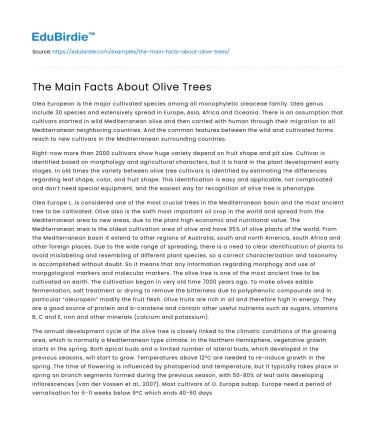Olea European is the major cultivated species among all monophyletic oleaceae family. Olea genus include 30 species and extensively spread in Europe, Asia, Africa and Oceania. There is an assumption that cultivars startred in wild Mediterranean olive and then carried with human through their migration to all Mediterranean neighboring countries. And the common features between the wild and cultivated forms reach to new cultivars in the Mediterranean surrounding countries.
Right-now more than 2000 cultivars show huge variety depend on fruit shape and pit size. Cultivar is identified based on morphology and agricultural characters, but it is hard in the plant development early stages. In old times the variety between olive tree cultivars is identified by estimating the differences regarding leaf shape, color, and fruit shape. This identification is easy and applicable, not complicated and don’t need special equipment, and the easiest way for recognition of olive tree is phenotype.
Save your time!
We can take care of your essay
- Proper editing and formatting
- Free revision, title page, and bibliography
- Flexible prices and money-back guarantee
Olea Europe L. is considered one of the most crucial trees in the Mediterranean basin and the most ancient tree to be caltivated. Olive also is the sixth most important oil crop in the world and spread from the Mediterranean area to new areas, due to the plant high economic and nutritional value. The Mediterranean area is the oldest cultivation area of olive and have 95% of olive plants of the world. From the Mediterranean basin it extend to other regions of Australia, south and north America, south Africa and other foreign places. Due to the wide range of spreading, there is a need to clear identification of plants to avoid mislabeling and resembling of different plant species, so a correct characterization and taxonomy is accomplished without doubt. So it means that any information regarding morphogy and use of morpgological markers and molecular markers. The olive tree is one of the most ancient tree to be cultivated on earth. The cultivation began in very old time 7000 years ago. To make olives edible fermentation, salt treatment or drying to remove the bitterness due to polyphenolic compounds and in particular “oleuropein” modify the fruit flesh. Olive fruits are rich in oil and therefore high in energy. They are a good source of protein and b-carotene and contain other useful nutrients such as sugars, vitamins B, C and E, iron and other minerals (calcium and potassium).
The annual development cycle of the olive tree is closely linked to the climatic conditions of the growing area, which is normally a Mediterranean type climate. In the Northern Hemisphere, vegetative growth starts in the spring. Both apical buds and a limited number of lateral buds, which developed in the previous seasons, will start to grow. Temperatures above 12°C are needed to re-induce growth in the spring. The time of flowering is influenced by photoperiod and temperature, but it typically takes place in spring on branch segments formed during the previous season, with 50-80% of leaf axils developing inflorescences (van der Vossen et al., 2007). Most cultivars of O. Europa subsp. Europe need a period of vernalisation for 6-11 weeks below 9°C which ends 40-60 days before anthesis. The initial elongation growth is rapid, particularly in the warmer growing regions. At temperatures above 30°C in mid-summer (mid-July), the vegetative growth rate drops. When there is enough moisture in the soil or under irrigated conditions, a short second period of growth could occur in the autumn with the reduction in daily temperatures. Thus, different types of growth curves of olive trees have been recorded in accordance with the thermal conditions in the summer. In most regions the bearing olive tree has a double peak growth curve. Europe subsp. Europe is strong biennial bearer and a heavy fruit load in one year inhibits adequate shoot extension necessary for the following year’s bearing wood and vice versa. In non-bearing trees a continuous but uneven flush of growth takes place along the whole March-October period.
The reproductive process leading to spring flowering starts in the preceding summers. The young buds present in the axial of each leaf on sprouts born in spring are undifferentiated. In summer, environmental factors interact with the tree physiology to start the floral induction process. Once induction is under way, floral initiation only occurs by the end of autumn, after which flower parts form. Eventually, these can be seen with a microscope. The buds not induced become vegetative buds. Unlike deciduous fruits with a short induction-to-initiation cycle, induction in olive may occur as early as July or about 6 weeks after full bloom, whereas initiation is not easily seen until 8 months later in February. Floral differentiation takes place between late December and bloom in May-June when the formation of each flower part occurs in the inflorescence.
The pollination of the olive is carried out mainly by wind. Growth and fruit development in olive also depends on climate, beginning in September and normally ending in November. Olives are picked late in autumn or winter, as the oil content and fruit characteristics change with ripening. Environmental variability may be more important than genetic variability for several traits, including oil content and quality. The chemical components (for example, polyphenols, aliphatic alcohols, triterpenic alcohols, sterols and fatty acids) that determine oil quality vary according to cultivar and year of cultivation. Rainfall is one of the predominant factors affecting oil quality. Irrigation may also affect the variability in oil quality. According to Van der Vossen et al. (2007) the commercial lifespan of an olive tree is 50 years, but individual trees can become very old (hundreds of years).






 Stuck on your essay?
Stuck on your essay?

